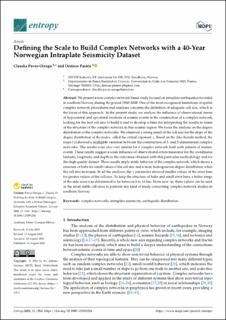| dc.contributor.author | Pavez-Orrego, Claudia | |
| dc.contributor.author | Pastén, Denisse | |
| dc.date.accessioned | 2024-04-10T13:42:37Z | |
| dc.date.available | 2024-04-10T13:42:37Z | |
| dc.date.created | 2023-10-14T12:52:57Z | |
| dc.date.issued | 2023 | |
| dc.identifier.citation | Entropy. 2023, 25 (9): 1284. | en_US |
| dc.identifier.issn | 1099-4300 | |
| dc.identifier.uri | https://hdl.handle.net/11250/3125861 | |
| dc.description.abstract | We present a new complex network-based study focused on intraplate earthquakes recorded in southern Norway during the period 1980–2020. One of the most recognized limitations of spatial complex network procedures and analyses concerns the definition of adequate cell size, which is the focus of this approach. In the present study, we analyze the influence of observational errors of hypocentral and epicentral locations of seismic events in the construction of a complex network, looking for the best cell size to build it and to develop a basis for interpreting the results in terms of the structure of the complex network in this seismic region. We focus the analysis on the degree distribution of the complex networks. We observed a strong result of the cell size for the slope of the degree distribution of the nodes, called the critical exponent . Based on the Abe–Suzuki method, the slope ( ) showed a negligible variation between the construction of 3- and 2-dimensional complex networks. The results were also very similar for a complex network built with subsets of seismic events. These results suggest a weak influence of observational errors measured for the coordinates latitude, longitude, and depth in the outcomes obtained with this particular methodology and for this high-quality dataset. These results imply stable behavior of the complex network, which shows a structure of hubs for small values of the cell size and a more homogeneous degree distribution when the cell size increases. In all the analyses, the parameter showed smaller values of the error bars for greater values of the cell size. To keep the structure of hubs and small error bars, a better range of the side sizes was determined to be between 8 to 16 km. From now on, these values can be used as the most stable cell sizes to perform any kind of study concerning complex network studies in southern Norway. | en_US |
| dc.language.iso | eng | en_US |
| dc.publisher | MDPI | en_US |
| dc.rights | Navngivelse 4.0 Internasjonal | * |
| dc.rights.uri | http://creativecommons.org/licenses/by/4.0/deed.no | * |
| dc.title | Defining the Scale to Build Complex Networks with a 40-Year Norwegian Intraplate Seismicity Dataset | en_US |
| dc.title.alternative | Defining the Scale to Build Complex Networks with a 40-Year Norwegian Intraplate Seismicity Dataset | en_US |
| dc.type | Peer reviewed | en_US |
| dc.type | Journal article | en_US |
| dc.description.version | publishedVersion | en_US |
| dc.rights.holder | © 2023 by the authors. Published by MDPI. | en_US |
| dc.source.pagenumber | 19 | en_US |
| dc.source.volume | 25 | en_US |
| dc.source.journal | Entropy | en_US |
| dc.source.issue | 9 | en_US |
| dc.identifier.doi | 10.3390/e25091284 | |
| dc.identifier.cristin | 2184693 | |
| dc.source.articlenumber | 1284 | en_US |
| cristin.ispublished | true | |
| cristin.fulltext | original | |
| cristin.qualitycode | 1 | |

